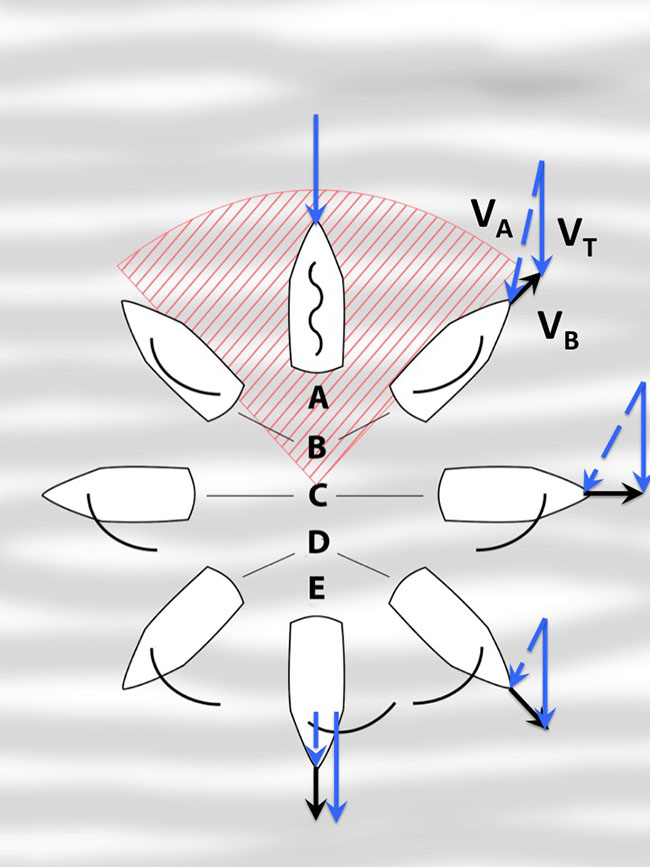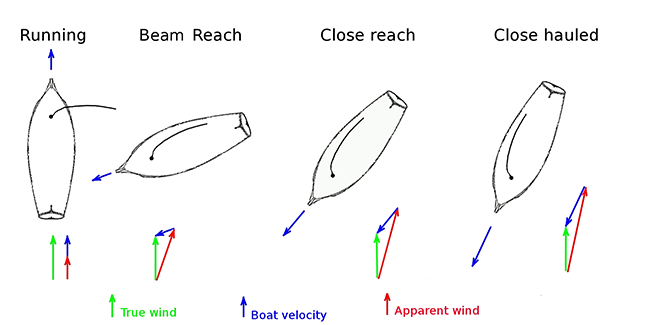Sailing Basics
Boat Terminology
Here is a detailed diagram of a sailboat and its components. This diagram goes into a little more detail than you need right now, so I will outline the important components for this course.

Source: By Jazzmanian at English Wikibooks - Transferred from en.wikibooks to Commons by Adrignola using CommonsHelper., Public Domain, https://commons.wikimedia.org/w/index.php?curid=10872236
Bow: front of the boat
Stern: rear of the boat
Port: left side of the boat
Starboard: right side of the boat
Hull: the main body of the boat
Keel: the long structure reaching down from the hull’s centerline beneath the boat (in the diagram, the boat has a centre board, which is just a removable keel. A keel is fixed). This helps control the boats balance as it moves through the water
Mast: the tall and upright structure on the boat to hold the sails
Boom: a spar along the foot of the main sail, attached to the mast. Aids in controlling the angle and shape of the sail
Main sail: the sail located on the mast over the centre of the boat
Jib the sail in front of the mast
Spinnaker: a large sail set in front of the mast when running downwind
Halyard: any rope used to raise or lower sails
Rudder: a flat blade at the stern of the boat used for steering
Points of Sail

Source: User:Andrew c - https://commons.wikimedia.org/wiki/File:Points_of_sail.svg,
CC BY-SA 3.0, https://commons.wikimedia.org/w/index.php?curid=38822837
A: Head into the wind (irons)
B: Close hauled (30-50o)
C: Beam Reach (90o)
D: Broad reach (~135o)
E: Running (180o)
In the diagram above, the wind direction is indicated by the solid blue arrows. Note that the position of the sail has been drawn for each point of sail. Basically, you gradually let out more and more sail as you turn away from the wind, starting with your sails almost all the way in when you’re close hauled, and completely out when you’re running.
Tack vs Jibe
To tack is to change direction by bringing the bow of the boat through the eye of the wind, ending with the wind coming over the opposite side of the boat. Your sails will also switch sides with the change of wind. You will travel from close hauled on one side of the wind to close hauled on the other side.
To jibe is the same, however performed while running downwind. Your sails will switch from one side of the boat to the other to allow you to change direction in relation to the wind.
Additional info for experts
The jibe can be more dangerous, since your sails are further out when you’re sailing downwind. In other words, your boom will likely be out about 90o on one side of the boat and will swing 180o across the cockpit to be 90o out on the opposite side. This swing happens very rapidly, especially when winds are strong, and the momentum of the boom could cause serious damage if you stand in the way. When tacking the sails are held closer in to the centre of the boat, meaning your sails are only swinging about 60o across the boat as you change direction.]
Apparent vs true wind speed
When you’re on a sailboat, there are two kinds of wind to think about. The true wind is the wind as it blows across the land or water, the wind in the weather forecasts, the wind you feel when you’re standing stationary on shore. However on a boat, you are moving due to wind and current, and so the apparent wind is how much wind you feel when standing on the boat. For instance, say there is no wind and you are driving under motor power at 4 knots. The apparent wind speed over your bow will be 4 knots. The apparent wind always takes into consideration the movement of the boat in relation to the true wind.

Source: Erwan1972 - Allure.jpg, CC BY-SA 3.0, https://commons.wikimedia.org/w/index.php?curid=15696626
Additional Resources
School of Sailing: www.schoolofsailing.net
Videos:
Volvo Race 2014-2015: https://www.youtube.com/watch?v=Iwztm1vAGL0